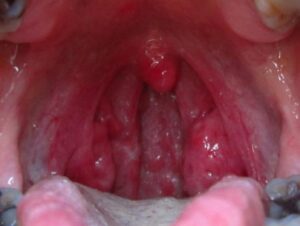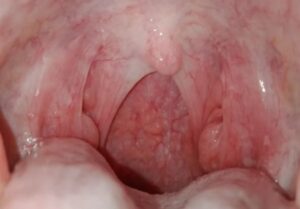A cobblestone throat is a condition that can be unsettling and uncomfortable. While it may not seem directly related to dental health, understanding its causes and treatment options is crucial for overall oral and throat well-being. In this article, we will explore what causes a cobblestone throat, how to get rid of it, which viruses can lead to this condition, and the role of salt water in its management.
Video Credits:- My Own Amazing Body
What Causes a Cobblestone In The Throat?
A cobblestone throat is a term used to describe the appearance of the back of the throat, particularly the posterior pharyngeal wall, which seems to have small, raised, red or white bumps. These bumps are actually lymphoid tissues, known as tonsillar or pharyngeal lymphoid tissue, and their enlargement is usually associated with underlying medical conditions. Here are some common causes:
 Allergies: Allergic reactions to pollen, dust mites, or certain foods can trigger the enlargement of the lymphoid tissues, resulting in a cobblestone appearance.
Allergies: Allergic reactions to pollen, dust mites, or certain foods can trigger the enlargement of the lymphoid tissues, resulting in a cobblestone appearance.
Postnasal Drip: Conditions such as chronic rhinitis or sinusitis can lead to postnasal drip, where mucus from the nose drips down the back of the throat, irritating and enlarging the lymphoid tissues.
Strep Throat: Streptococcal infections, commonly referred to as strep throat, can cause inflammation and swelling of the tonsils and pharyngeal tissues, contributing to a cobblestone appearance.
Viral Infections: Several viruses, including Epstein-Barr virus (EBV) and adenovirus, can lead to a cobblestone throat as the immune system responds to the infection by increasing the size of the lymphoid tissues.
How Do You Get Rid of a Cobblestone Throat?
Getting rid of a cobblestone throat often involves addressing the underlying cause.
Here are some steps to consider:
Identify the Cause: Consult a healthcare provider, preferably an ear, nose, and throat (ENT) specialist or a dentist, to determine the underlying cause of your cobblestone throat.
Treatment for Allergies: If allergies are the culprit, your healthcare provider may recommend antihistamines, decongestants, or allergy shots to manage your symptoms.
Antibiotics: In cases of strep throat or bacterial infections, antibiotics may be prescribed to treat the infection and reduce throat inflammation.
Viral Infections: Viral infections typically resolve on their own with rest and hydration. Your healthcare provider may recommend over-the-counter pain relievers and throat lozenges to ease discomfort.
Hydration: Stay well-hydrated by drinking plenty of water to soothe your throat and facilitate recovery.
What Virus Causes Cobblestone Throat?
Several viruses can lead to a cobblestone throat, but Epstein-Barr virus (EBV) is a common culprit. EBV is a member of the herpesvirus family and is responsible for mononucleosis, commonly known as mono. Adenovirus, another respiratory virus, can also cause lymphoid tissue enlargement in the throat, resulting in a cobblestone appearance.

Does Salt Water Help Cobblestone Throat?
Gargling with warm salt water can provide temporary relief from the discomfort associated with a cobblestone throat. Salt water can help soothe irritation, reduce inflammation, and alleviate throat soreness. To make a saltwater gargle, dissolve half a teaspoon of salt in a glass of warm water and use it for gargling several times a day. However, it’s essential to remember that this is a supportive measure and not a cure for the underlying condition causing the cobblestone throat.
Will Cobblestone Throat Go Away?
The outlook for a cobblestone in the throat largely depends on its underlying cause. If the condition is due to allergies or a viral infection, it will often resolve on its own with time and proper management. However, if a bacterial infection like strep throat is the cause, antibiotics can help speed up the recovery process. Regular follow-ups with a healthcare provider or dentist can ensure that the condition is monitored and treated appropriately until it completely resolves.
Conclusion
While a cobblestone throat may not seem directly related to dental health, understanding its causes and treatments is essential for overall well-being. If you suspect you have a cobblestone in the throat or are experiencing discomfort in your throat, consult a healthcare provider or dentist for a proper diagnosis and guidance on managing the condition. Proper care and attention can help you find relief and ensure the health of your throat and mouth.
